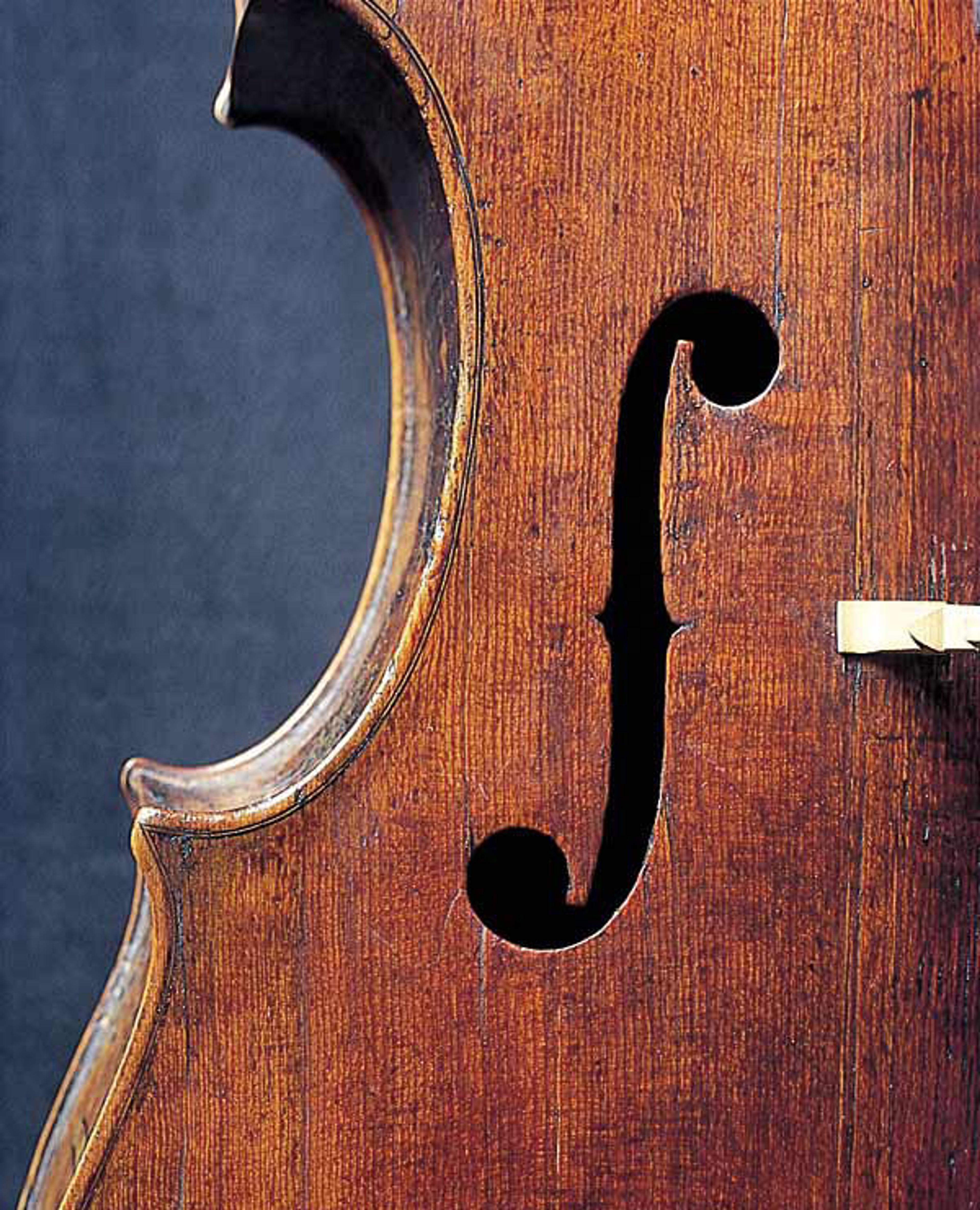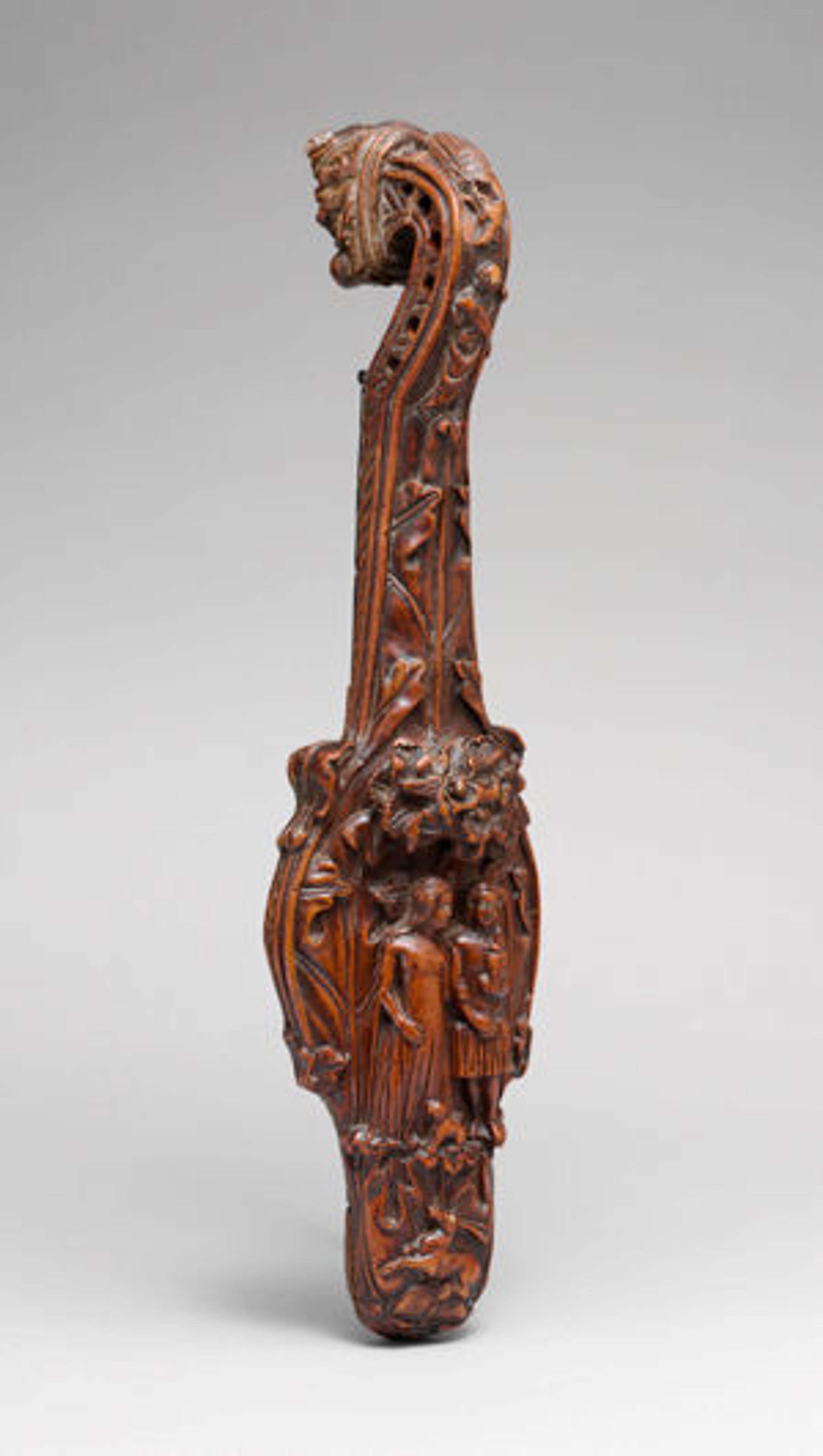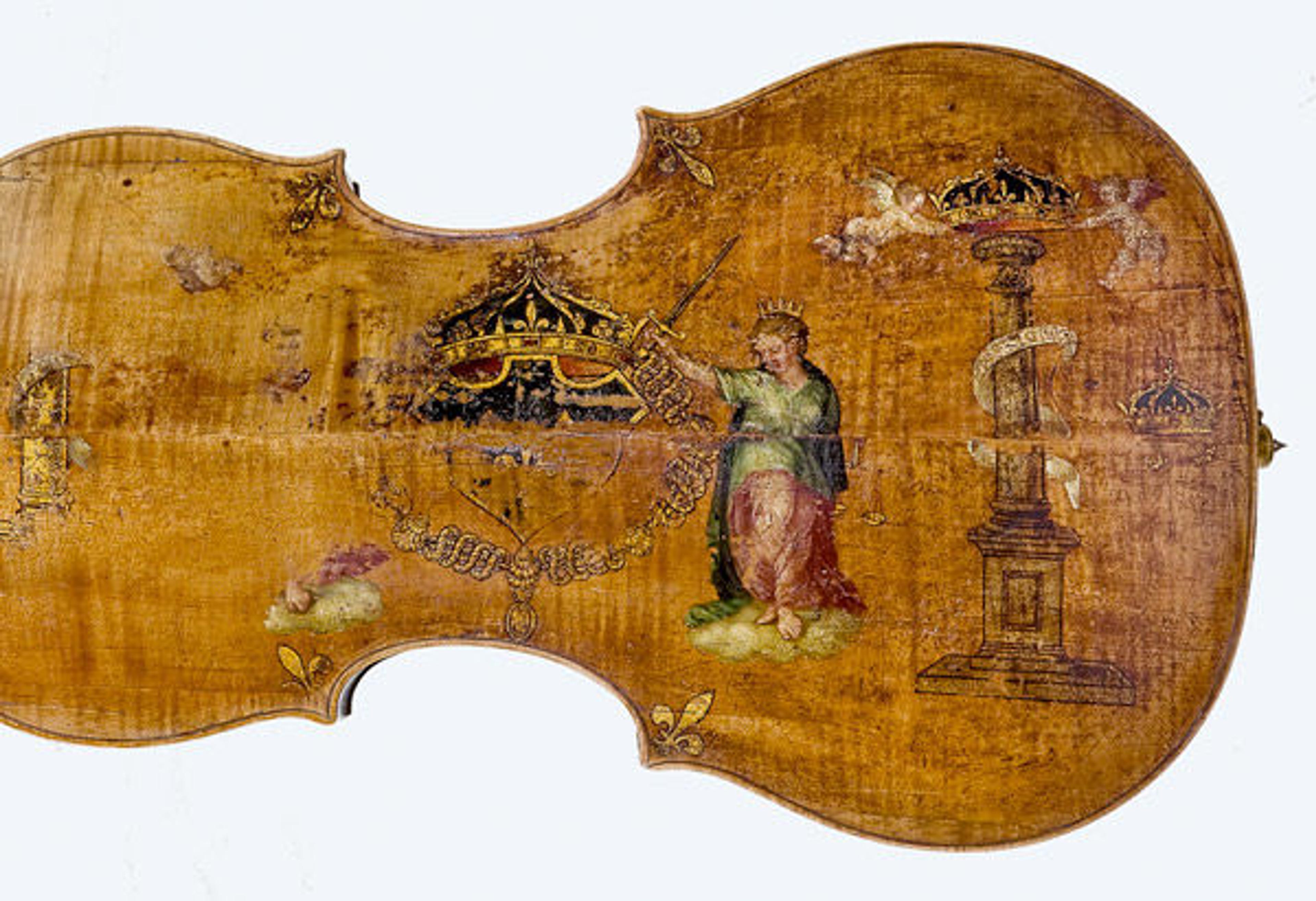Now on View: Andrea Amati's "King" Cello, on Loan from the National Music Museum

Andrea Amati (Italian, ca. 1505–1578). Violoncello, "The King" (detail), mid-16th century. National Music Museum, Vermillion, South Dakota, Witten-Rawlins Collection, 1984 (NMM 3351)
«For centuries, the Amati name has been lauded in connection with the violins, violas, and cellos produced by the family's four generations of instrument makers in the Tuscan city of Cremona. The early history of Cremonese lutherie is shrouded in mystery, but the survival of around two dozen instruments by Andrea Amati (ca. 1505–1577) is a testament to both the astonishingly high quality of violin making in Cremona, and also to the extent to which these instruments were treasured, repaired, and modified for players and collectors for five centuries. The "King" cello by Andrea Amati, painted with the armorials and mottos of King Charles IX of France (1550–1574), reflects a long history of fine European musical instruments of noble provenance. Now in the permanent collection of the National Music Museum in Vermillion, South Dakota, the "King" cello has been graciously loaned to the Met for display in The André Mertens Galleries for Musical Instruments from June 11 through September 8, 2015.»
The production of valuable, decorative musical instruments has a strong tradition in Renaissance Italy. Isabella d'Este (1474–1539), Marchesa of Mantua, was famously a devoted collector of luxury musical instruments who collaborated with some of the great makers of her time. While none of the instruments made for her are known to survive, the Metropolitan Museum has a slightly earlier mandora that illustrates the high quality of work in early Renaissance Italy.
Left: Mandora, ca. 1420. Italian. Boxwood, rosewood. The Metropolitan Museum of Art, New York, Gift of Irwin Untermyer, 1964 (64.101.1409)

Italian culture was extremely important to Isabella's younger contemporary, King Francis I of France (1494–1547), and his importation of great Italian artists and artisans to France initiated the French Renaissance in art, architecture, and music. Italian musicians were on the payroll of the court by 1529, and it is likely that Italian instruments began to be used in France during this period. The earliest evidence of the presence of Andrea Amati instruments at the French court is the survival of a modified viola, now at the National Music Museum, bearing the motto of Francis's son, Henry II (1519–1559), Donec totum impleat orbem. The motto was used by Henry between 1536 and 1559, making this the earliest documented extant instrument of the violin family.
The recent discovery of this viola bolsters the idea that Amati instruments were at the French court for an extended time before a set was painted for Henry's son, Charles IX. The style of painting on the surviving Charles IX instruments varies considerably, and it is possible that a number of them may have been repurposed from earlier sets, such as the one made for Henry II, and a second set bearing the motto Quo unico propugnaculo stat stabitque religio, which may have been made for the 1559 wedding of Philip II of Spain and Henry's daughter Elisabeth. An instrument from this latter set, the ex-"Kurtz" violin, is part of the Metropolitan Museum's collection.
Right: Andrea Amati (Italian, ca. 1505–1578). Ex-"Kurtz" Violin, ca. 1650. Italian (Cremona). Spruce, maple, ebony. The Metropolitan Museum of Art, New York, Purchase, Robert Alonzo Lehman Bequest, 1999 (1999.26)

Due to some stylistic aspects of its construction, including the shape of the sound holes and scroll, scholars currently believe that the "King" may predate its decoration in the 1560s. The instrument was originally a bass violin of considerably larger dimensions than it appears today, but as musical demands changed over time, valuable instruments such as this one were repaired and modified to suit the needs of later periods. In order to reduce the size to that of a violoncello, wood was removed along the center joint and from the upper and lower edges, which can be readily noticed due to the changes visible on the surviving painted decoration of the back.
The story of the "King" after its existence in the French court continues into the early nineteenth century, when the market for fine antique Italian instruments was blossoming. The cello bears the repair inscription of Sèbastien Renault of Paris, best known as a harp builder, who reconstructed the instrument in 1801. It is likely that the instrument was cut down in size and modernized at this time, but at the very least it received extensive repairs necessitated by age or malicious damage.

Due to the instrument likely being cut down in size, one can see that wood was removed down the center—leaving the woman, representing Justice, without a waist or left arm. Photo courtesy of the National Music Museum
In Chats on Violoncellos (London: J.B. Lippincott Company, 1907), Olga Racster wrote of a piece of apocryphal paper preserved with the instrument at that time, inscribed "Basse fatte par erndre ermati Luthiér â cremonne eu italie en 1572. envoyez par le pape 3: à Charles 9 roi de france pour sa chapelle.-avec ses amories et se devise, pietate justicia." (Bass made by Andrea Amati, luthier in Cremona, Italy, in 1572. Sent by the pope to Charles IX for his chapel, with the armorials and device Piety and Justice.) Further text had been added in English by Canon A. H. Bridges, according to Racster, that "Duport had it," and "a Hollander brought it to Betts in 1812, and he sold it to H. W. Curtis." Racster stated that the instrument was sold by Sir William Curtis at an auction on May 3, 1829, and she cites the following text in the auction catalog:
Lot 9, a violoncello by Andrea Amati Cremonencis Faciebat, 1572. A document was given to the proprietor when he purchased this instrument, stating that it was presented by Pope Pius V. to Charles IX., King of France, for his chapel. It has been richly decorated, the arms of France being on the back and the motto "Pietate et Justitia" [sic] on the sides. The tone of this violoncello is of extraordinary power and richness.
Canon A. H. Bridges, rector of Beddington, acquired the instrument at about this time, possibly at the auction, and it was in the possession of his son, John Henry Bridges, Ewell Court, Surrey, when Racster's book was published. Sometime between 1907 and 1967, when Laurence Witten purchased the "King" from Rembert Wurlitzer, this dubious slip of paper was lost. Prior to its purchase by Witten, the instrument had also belonged to cellist Carlos Prieto.
The "King" has appeared in eight historic temporary exhibitions over the last 143 years, including the 1872 Special Exhibition of Ancient Musical Instruments at the South Kensington Museum (today the Victoria and Albert Museum), London; the 1904 Music Loan Exhibition, London; and, most recently, the 2007 Opera Omnia exhibit in Cremona, in which the majority of surviving instruments by Andrea Amati were assembled in one hall, including all three of the instruments that can be seen in the Met's galleries this summer.
Arian Sheets
Arian Sheets is the curator of Stringed Instruments at the National Music Museum in Vermillion, South Dakota.